MBA Capstone: Influence Strategies, Leadership in Fujairah Schools
VerifiedAdded on 2022/11/14
|37
|8738
|147
Project
AI Summary
This capstone research paper investigates the influence strategies and leadership styles employed in managing people within school settings in Fujairah and Khor Fakkan, UAE. The study explores the relationship between leadership and power, examining how different influence strategies impact organizational climate and management effectiveness. The research utilizes a variety of theoretical frameworks, including trait, behavioral, and situational approaches, to analyze leadership models. The study's objectives include understanding leadership styles, establishing the correlation between leadership and power, and identifying which strategies yield better management practices. The methodology includes research design, instrumentation, and statistical analysis, with findings presented in tables and figures. The research concludes that effective management depends on understanding organizational climates and adapting influence strategies accordingly, offering recommendations for school managers to improve leadership effectiveness.

1
ACKNOWLEDGMENT
(SAMPLE)
I would like to give my special thanks to……
Name ___________________________
ACKNOWLEDGMENT
(SAMPLE)
I would like to give my special thanks to……
Name ___________________________
Paraphrase This Document
Need a fresh take? Get an instant paraphrase of this document with our AI Paraphraser

2
ACCEPTANCE SHEET
The capstone research paper entitled
“______________________________________________________________________________”
Submitted by ___________________________, in partial fulfilment of the requirements for MBA
612 Strategic Management (Capstone) for the degree, Master of Business Administration from the
University of Fujairah is hereby accepted.
_____________________________________
Dr. Fermin G. Castillo, Jr.
Capstone Supervisor
ACCEPTANCE SHEET
The capstone research paper entitled
“______________________________________________________________________________”
Submitted by ___________________________, in partial fulfilment of the requirements for MBA
612 Strategic Management (Capstone) for the degree, Master of Business Administration from the
University of Fujairah is hereby accepted.
_____________________________________
Dr. Fermin G. Castillo, Jr.
Capstone Supervisor
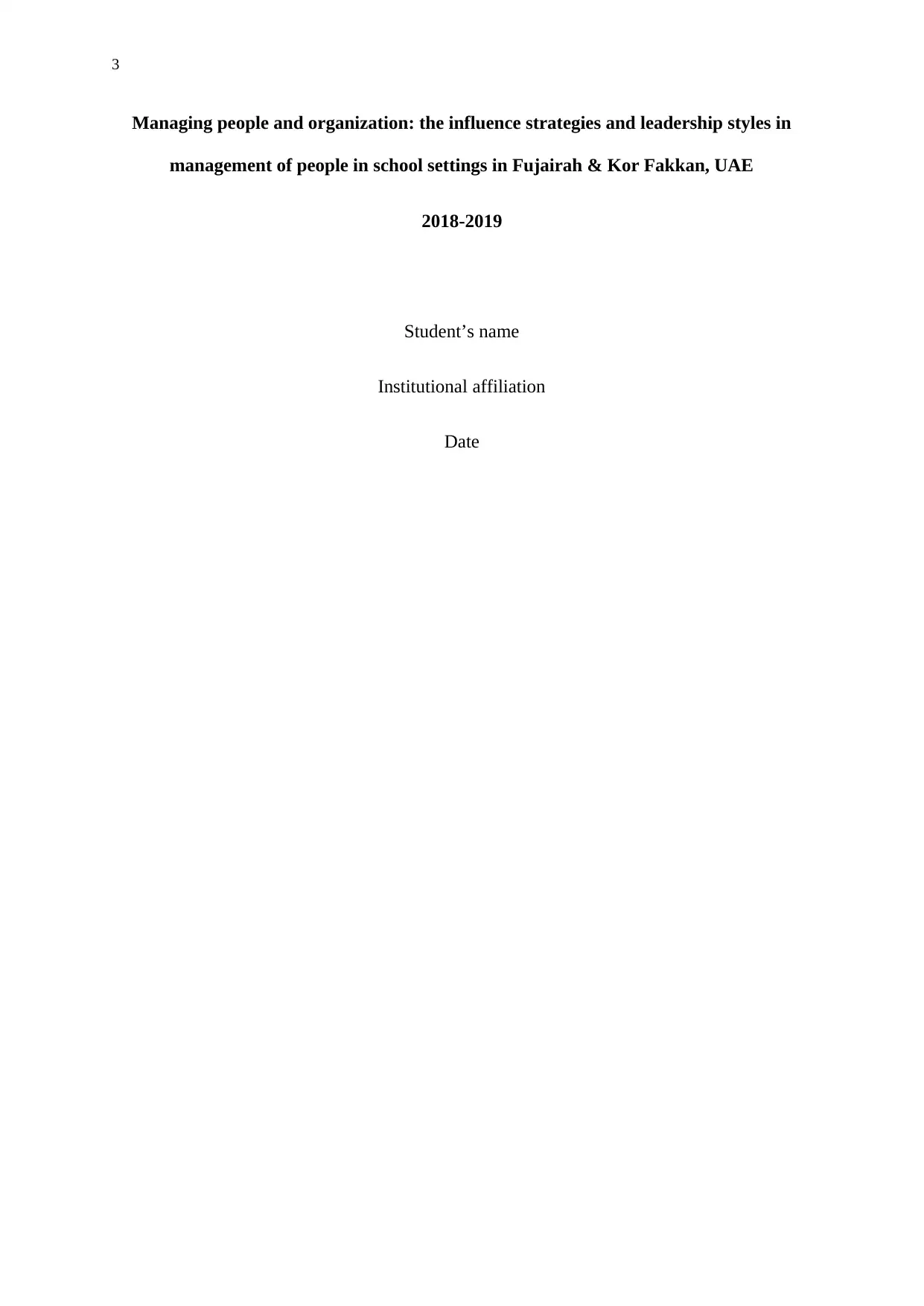
3
Managing people and organization: the influence strategies and leadership styles in
management of people in school settings in Fujairah & Kor Fakkan, UAE
2018-2019
Student’s name
Institutional affiliation
Date
Managing people and organization: the influence strategies and leadership styles in
management of people in school settings in Fujairah & Kor Fakkan, UAE
2018-2019
Student’s name
Institutional affiliation
Date
⊘ This is a preview!⊘
Do you want full access?
Subscribe today to unlock all pages.

Trusted by 1+ million students worldwide

MANAGING PEOPLE AND ORGANIZATION 4
Managing people and organization: the influence strategies and leadership styles in
management of people at work places
ABSTRACT
This research study seeks to determine the influence strategies and leadership styles in
a workplace management of different people working in schools around Fujairah and Khor
Fakkan area. Managers in different school settings exercise the concept of leadership in most
of their duties towards their respective subordinates. The concept of leadership in most cases
involves power usage over an individual's superiors or subordinates. As the aspects of power
and leadership have been studied on an extensive manner by different social psychologists
across the world, limited evidence has been provided as far as the relationship of these two
aspects is concerned. This research paper intends to explore and further integrate two major
human work associated recalcitrant issues. The paper will present an extended discussion on
the literature concerning influence strategies and leadership styles a school setting. This
research study views the aspect of leadership as a reciprocal process of influence and the
concept of power as any kind of "potential influence" and therefore the interconnection
between these two concepts is known as "influence." This research paper further presents
different major research findings obtained from the research study putting into consideration
five major aspects. Among these includes power bases, the style of leadership, the behaviour
of leaders, the organizational culture or climate and the characteristics of the organizations.
Depending on extensive data quantification, this research concludes that the different
influence strategies that managers employ in leadership cannot be fixed in a universal
manner. However, different school managers need to understand their organizational climates
in order to ensure effective management.
Managing people and organization: the influence strategies and leadership styles in
management of people at work places
ABSTRACT
This research study seeks to determine the influence strategies and leadership styles in
a workplace management of different people working in schools around Fujairah and Khor
Fakkan area. Managers in different school settings exercise the concept of leadership in most
of their duties towards their respective subordinates. The concept of leadership in most cases
involves power usage over an individual's superiors or subordinates. As the aspects of power
and leadership have been studied on an extensive manner by different social psychologists
across the world, limited evidence has been provided as far as the relationship of these two
aspects is concerned. This research paper intends to explore and further integrate two major
human work associated recalcitrant issues. The paper will present an extended discussion on
the literature concerning influence strategies and leadership styles a school setting. This
research study views the aspect of leadership as a reciprocal process of influence and the
concept of power as any kind of "potential influence" and therefore the interconnection
between these two concepts is known as "influence." This research paper further presents
different major research findings obtained from the research study putting into consideration
five major aspects. Among these includes power bases, the style of leadership, the behaviour
of leaders, the organizational culture or climate and the characteristics of the organizations.
Depending on extensive data quantification, this research concludes that the different
influence strategies that managers employ in leadership cannot be fixed in a universal
manner. However, different school managers need to understand their organizational climates
in order to ensure effective management.
Paraphrase This Document
Need a fresh take? Get an instant paraphrase of this document with our AI Paraphraser
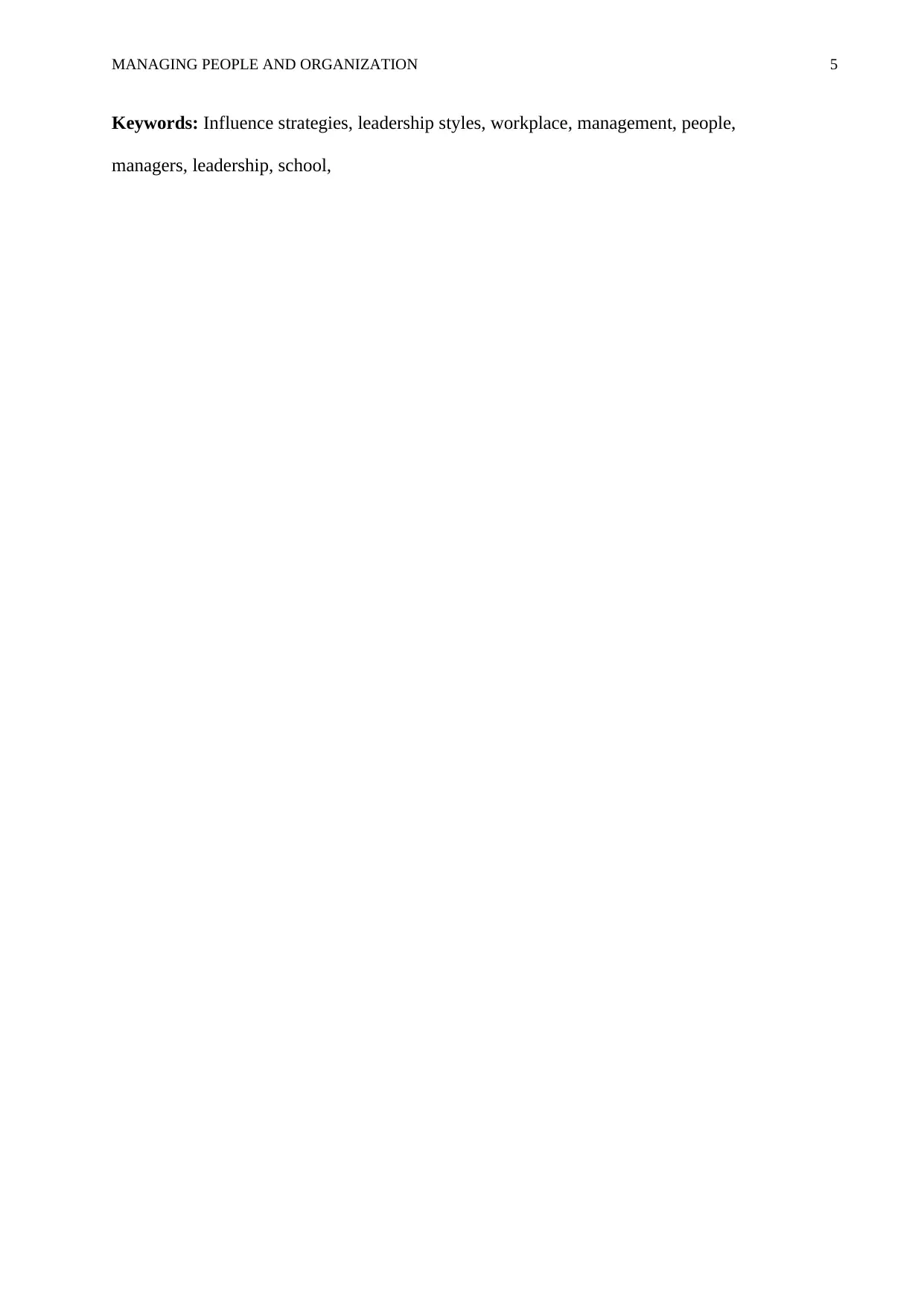
MANAGING PEOPLE AND ORGANIZATION 5
Keywords: Influence strategies, leadership styles, workplace, management, people,
managers, leadership, school,
Keywords: Influence strategies, leadership styles, workplace, management, people,
managers, leadership, school,
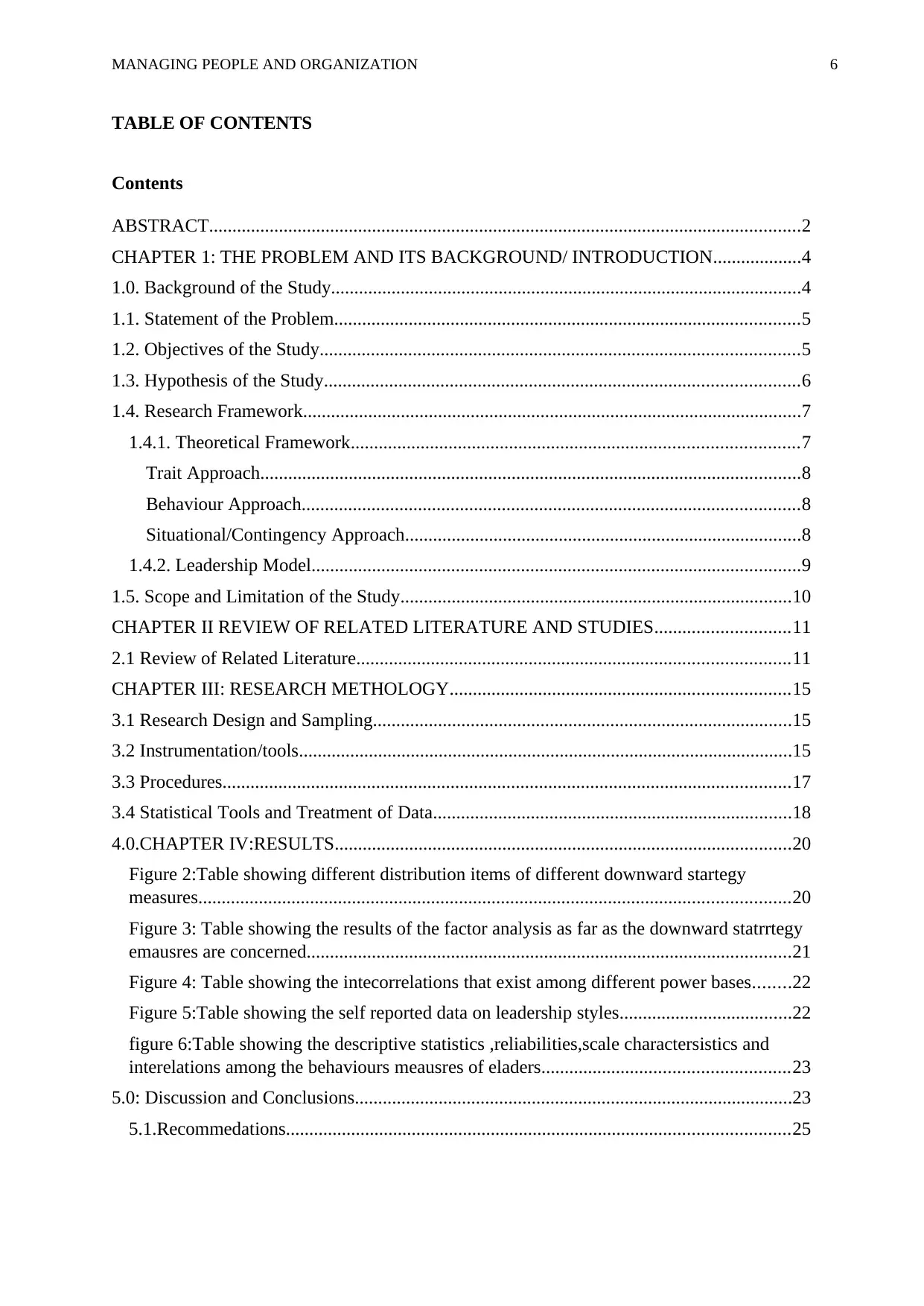
MANAGING PEOPLE AND ORGANIZATION 6
TABLE OF CONTENTS
Contents
ABSTRACT...............................................................................................................................2
CHAPTER 1: THE PROBLEM AND ITS BACKGROUND/ INTRODUCTION...................4
1.0. Background of the Study.....................................................................................................4
1.1. Statement of the Problem....................................................................................................5
1.2. Objectives of the Study.......................................................................................................5
1.3. Hypothesis of the Study......................................................................................................6
1.4. Research Framework...........................................................................................................7
1.4.1. Theoretical Framework................................................................................................7
Trait Approach....................................................................................................................8
Behaviour Approach...........................................................................................................8
Situational/Contingency Approach.....................................................................................8
1.4.2. Leadership Model.........................................................................................................9
1.5. Scope and Limitation of the Study....................................................................................10
CHAPTER II REVIEW OF RELATED LITERATURE AND STUDIES.............................11
2.1 Review of Related Literature.............................................................................................11
CHAPTER III: RESEARCH METHOLOGY.........................................................................15
3.1 Research Design and Sampling..........................................................................................15
3.2 Instrumentation/tools..........................................................................................................15
3.3 Procedures..........................................................................................................................17
3.4 Statistical Tools and Treatment of Data.............................................................................18
4.0.CHAPTER IV:RESULTS..................................................................................................20
Figure 2:Table showing different distribution items of different downward startegy
measures...............................................................................................................................20
Figure 3: Table showing the results of the factor analysis as far as the downward statrrtegy
emausres are concerned........................................................................................................21
Figure 4: Table showing the intecorrelations that exist among different power bases........22
Figure 5:Table showing the self reported data on leadership styles.....................................22
figure 6:Table showing the descriptive statistics ,reliabilities,scale charactersistics and
interelations among the behaviours meausres of eladers.....................................................23
5.0: Discussion and Conclusions..............................................................................................23
5.1.Recommedations............................................................................................................25
TABLE OF CONTENTS
Contents
ABSTRACT...............................................................................................................................2
CHAPTER 1: THE PROBLEM AND ITS BACKGROUND/ INTRODUCTION...................4
1.0. Background of the Study.....................................................................................................4
1.1. Statement of the Problem....................................................................................................5
1.2. Objectives of the Study.......................................................................................................5
1.3. Hypothesis of the Study......................................................................................................6
1.4. Research Framework...........................................................................................................7
1.4.1. Theoretical Framework................................................................................................7
Trait Approach....................................................................................................................8
Behaviour Approach...........................................................................................................8
Situational/Contingency Approach.....................................................................................8
1.4.2. Leadership Model.........................................................................................................9
1.5. Scope and Limitation of the Study....................................................................................10
CHAPTER II REVIEW OF RELATED LITERATURE AND STUDIES.............................11
2.1 Review of Related Literature.............................................................................................11
CHAPTER III: RESEARCH METHOLOGY.........................................................................15
3.1 Research Design and Sampling..........................................................................................15
3.2 Instrumentation/tools..........................................................................................................15
3.3 Procedures..........................................................................................................................17
3.4 Statistical Tools and Treatment of Data.............................................................................18
4.0.CHAPTER IV:RESULTS..................................................................................................20
Figure 2:Table showing different distribution items of different downward startegy
measures...............................................................................................................................20
Figure 3: Table showing the results of the factor analysis as far as the downward statrrtegy
emausres are concerned........................................................................................................21
Figure 4: Table showing the intecorrelations that exist among different power bases........22
Figure 5:Table showing the self reported data on leadership styles.....................................22
figure 6:Table showing the descriptive statistics ,reliabilities,scale charactersistics and
interelations among the behaviours meausres of eladers.....................................................23
5.0: Discussion and Conclusions..............................................................................................23
5.1.Recommedations............................................................................................................25
⊘ This is a preview!⊘
Do you want full access?
Subscribe today to unlock all pages.

Trusted by 1+ million students worldwide
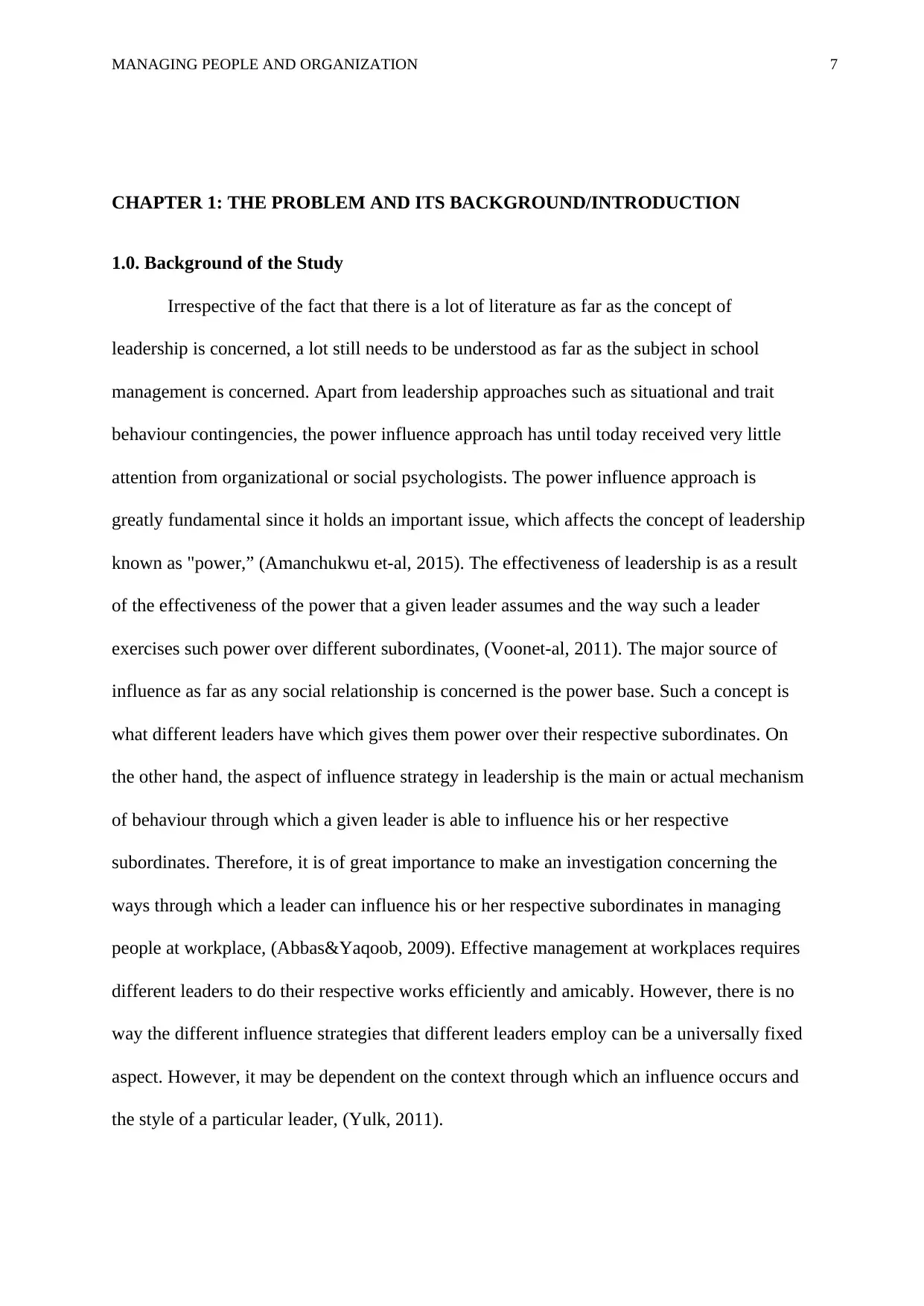
MANAGING PEOPLE AND ORGANIZATION 7
CHAPTER 1: THE PROBLEM AND ITS BACKGROUND/INTRODUCTION
1.0. Background of the Study
Irrespective of the fact that there is a lot of literature as far as the concept of
leadership is concerned, a lot still needs to be understood as far as the subject in school
management is concerned. Apart from leadership approaches such as situational and trait
behaviour contingencies, the power influence approach has until today received very little
attention from organizational or social psychologists. The power influence approach is
greatly fundamental since it holds an important issue, which affects the concept of leadership
known as "power,” (Amanchukwu et-al, 2015). The effectiveness of leadership is as a result
of the effectiveness of the power that a given leader assumes and the way such a leader
exercises such power over different subordinates, (Voonet-al, 2011). The major source of
influence as far as any social relationship is concerned is the power base. Such a concept is
what different leaders have which gives them power over their respective subordinates. On
the other hand, the aspect of influence strategy in leadership is the main or actual mechanism
of behaviour through which a given leader is able to influence his or her respective
subordinates. Therefore, it is of great importance to make an investigation concerning the
ways through which a leader can influence his or her respective subordinates in managing
people at workplace, (Abbas&Yaqoob, 2009). Effective management at workplaces requires
different leaders to do their respective works efficiently and amicably. However, there is no
way the different influence strategies that different leaders employ can be a universally fixed
aspect. However, it may be dependent on the context through which an influence occurs and
the style of a particular leader, (Yulk, 2011).
CHAPTER 1: THE PROBLEM AND ITS BACKGROUND/INTRODUCTION
1.0. Background of the Study
Irrespective of the fact that there is a lot of literature as far as the concept of
leadership is concerned, a lot still needs to be understood as far as the subject in school
management is concerned. Apart from leadership approaches such as situational and trait
behaviour contingencies, the power influence approach has until today received very little
attention from organizational or social psychologists. The power influence approach is
greatly fundamental since it holds an important issue, which affects the concept of leadership
known as "power,” (Amanchukwu et-al, 2015). The effectiveness of leadership is as a result
of the effectiveness of the power that a given leader assumes and the way such a leader
exercises such power over different subordinates, (Voonet-al, 2011). The major source of
influence as far as any social relationship is concerned is the power base. Such a concept is
what different leaders have which gives them power over their respective subordinates. On
the other hand, the aspect of influence strategy in leadership is the main or actual mechanism
of behaviour through which a given leader is able to influence his or her respective
subordinates. Therefore, it is of great importance to make an investigation concerning the
ways through which a leader can influence his or her respective subordinates in managing
people at workplace, (Abbas&Yaqoob, 2009). Effective management at workplaces requires
different leaders to do their respective works efficiently and amicably. However, there is no
way the different influence strategies that different leaders employ can be a universally fixed
aspect. However, it may be dependent on the context through which an influence occurs and
the style of a particular leader, (Yulk, 2011).
Paraphrase This Document
Need a fresh take? Get an instant paraphrase of this document with our AI Paraphraser
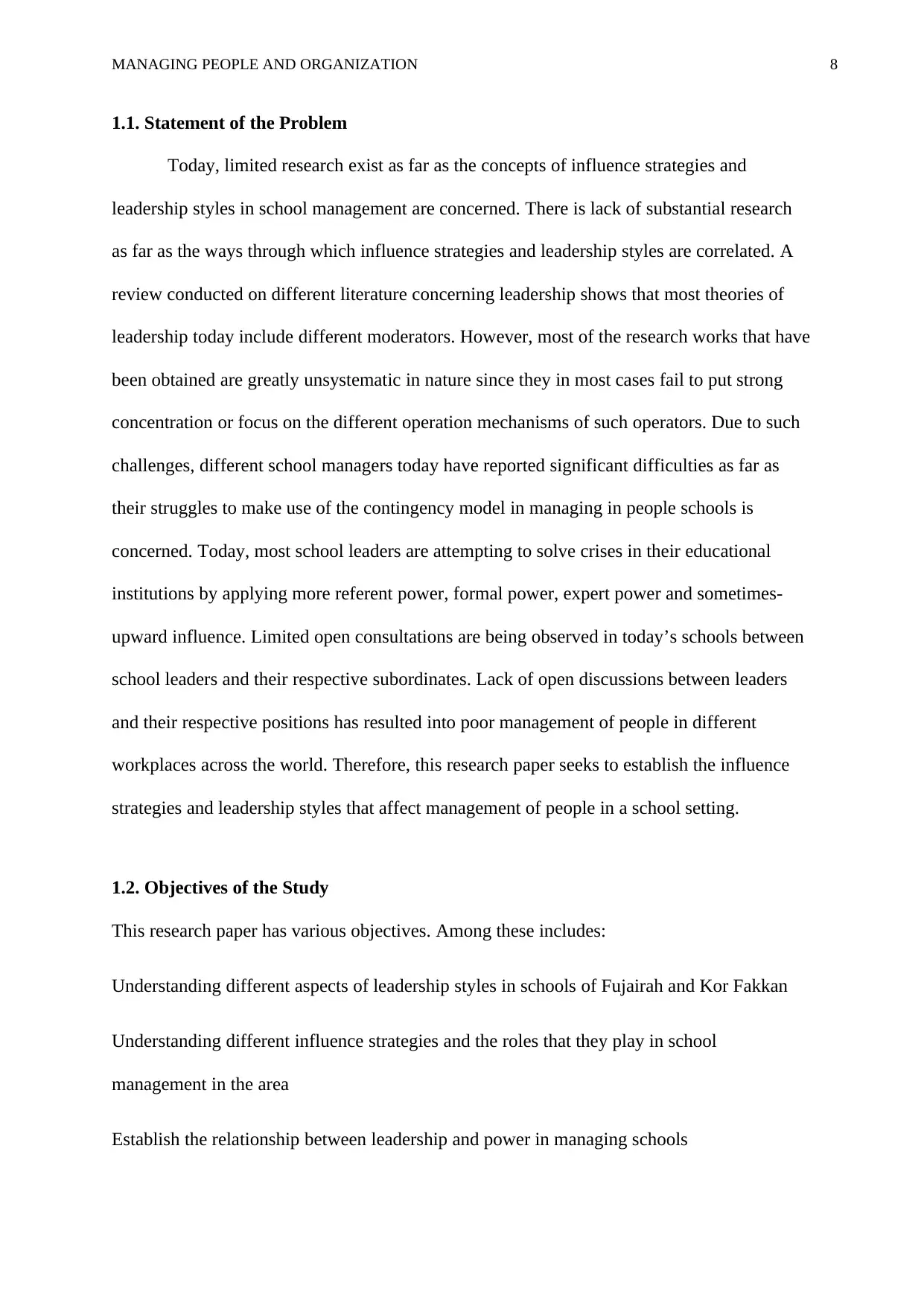
MANAGING PEOPLE AND ORGANIZATION 8
1.1. Statement of the Problem
Today, limited research exist as far as the concepts of influence strategies and
leadership styles in school management are concerned. There is lack of substantial research
as far as the ways through which influence strategies and leadership styles are correlated. A
review conducted on different literature concerning leadership shows that most theories of
leadership today include different moderators. However, most of the research works that have
been obtained are greatly unsystematic in nature since they in most cases fail to put strong
concentration or focus on the different operation mechanisms of such operators. Due to such
challenges, different school managers today have reported significant difficulties as far as
their struggles to make use of the contingency model in managing in people schools is
concerned. Today, most school leaders are attempting to solve crises in their educational
institutions by applying more referent power, formal power, expert power and sometimes-
upward influence. Limited open consultations are being observed in today’s schools between
school leaders and their respective subordinates. Lack of open discussions between leaders
and their respective positions has resulted into poor management of people in different
workplaces across the world. Therefore, this research paper seeks to establish the influence
strategies and leadership styles that affect management of people in a school setting.
1.2. Objectives of the Study
This research paper has various objectives. Among these includes:
Understanding different aspects of leadership styles in schools of Fujairah and Kor Fakkan
Understanding different influence strategies and the roles that they play in school
management in the area
Establish the relationship between leadership and power in managing schools
1.1. Statement of the Problem
Today, limited research exist as far as the concepts of influence strategies and
leadership styles in school management are concerned. There is lack of substantial research
as far as the ways through which influence strategies and leadership styles are correlated. A
review conducted on different literature concerning leadership shows that most theories of
leadership today include different moderators. However, most of the research works that have
been obtained are greatly unsystematic in nature since they in most cases fail to put strong
concentration or focus on the different operation mechanisms of such operators. Due to such
challenges, different school managers today have reported significant difficulties as far as
their struggles to make use of the contingency model in managing in people schools is
concerned. Today, most school leaders are attempting to solve crises in their educational
institutions by applying more referent power, formal power, expert power and sometimes-
upward influence. Limited open consultations are being observed in today’s schools between
school leaders and their respective subordinates. Lack of open discussions between leaders
and their respective positions has resulted into poor management of people in different
workplaces across the world. Therefore, this research paper seeks to establish the influence
strategies and leadership styles that affect management of people in a school setting.
1.2. Objectives of the Study
This research paper has various objectives. Among these includes:
Understanding different aspects of leadership styles in schools of Fujairah and Kor Fakkan
Understanding different influence strategies and the roles that they play in school
management in the area
Establish the relationship between leadership and power in managing schools
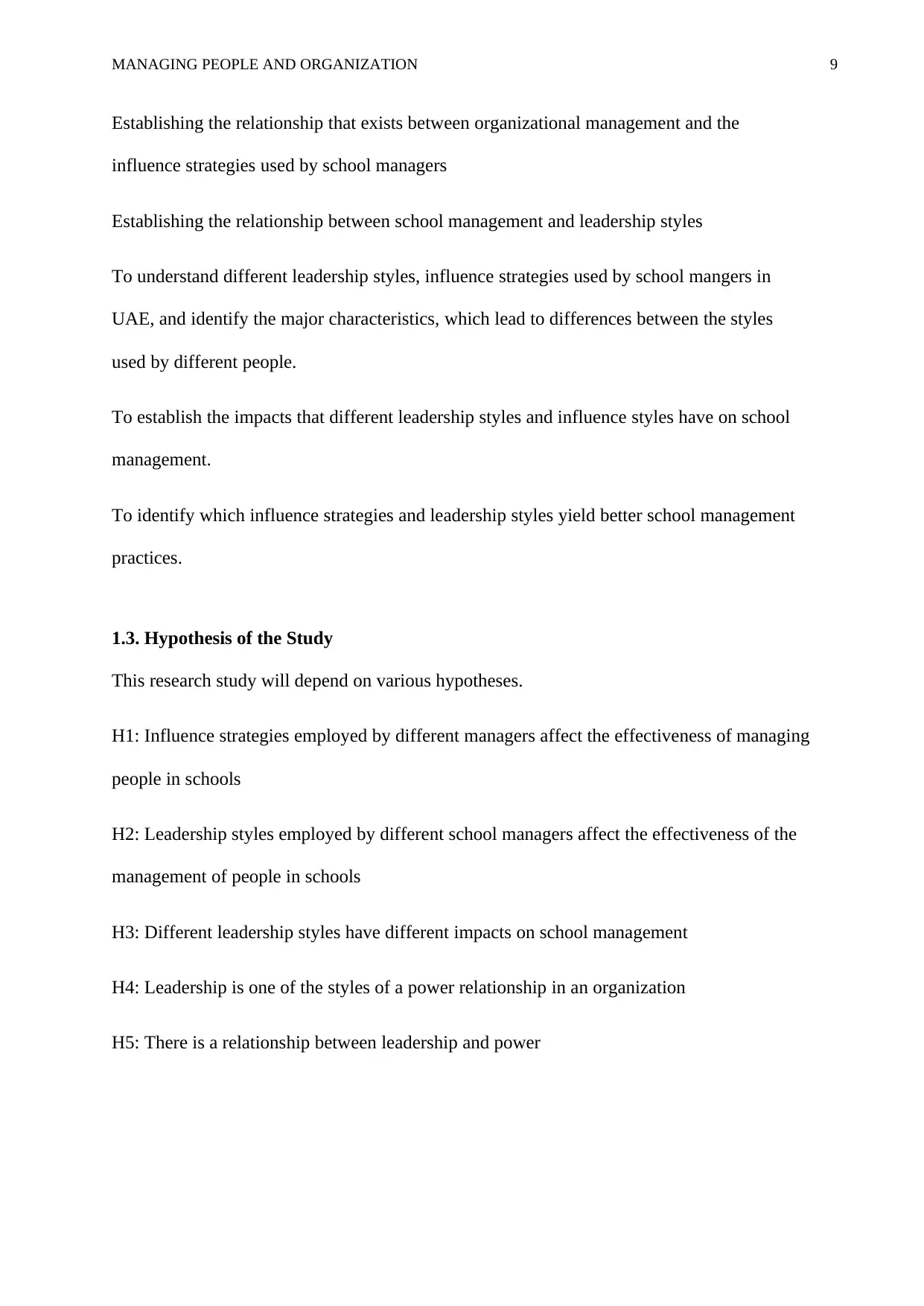
MANAGING PEOPLE AND ORGANIZATION 9
Establishing the relationship that exists between organizational management and the
influence strategies used by school managers
Establishing the relationship between school management and leadership styles
To understand different leadership styles, influence strategies used by school mangers in
UAE, and identify the major characteristics, which lead to differences between the styles
used by different people.
To establish the impacts that different leadership styles and influence styles have on school
management.
To identify which influence strategies and leadership styles yield better school management
practices.
1.3. Hypothesis of the Study
This research study will depend on various hypotheses.
H1: Influence strategies employed by different managers affect the effectiveness of managing
people in schools
H2: Leadership styles employed by different school managers affect the effectiveness of the
management of people in schools
H3: Different leadership styles have different impacts on school management
H4: Leadership is one of the styles of a power relationship in an organization
H5: There is a relationship between leadership and power
Establishing the relationship that exists between organizational management and the
influence strategies used by school managers
Establishing the relationship between school management and leadership styles
To understand different leadership styles, influence strategies used by school mangers in
UAE, and identify the major characteristics, which lead to differences between the styles
used by different people.
To establish the impacts that different leadership styles and influence styles have on school
management.
To identify which influence strategies and leadership styles yield better school management
practices.
1.3. Hypothesis of the Study
This research study will depend on various hypotheses.
H1: Influence strategies employed by different managers affect the effectiveness of managing
people in schools
H2: Leadership styles employed by different school managers affect the effectiveness of the
management of people in schools
H3: Different leadership styles have different impacts on school management
H4: Leadership is one of the styles of a power relationship in an organization
H5: There is a relationship between leadership and power
⊘ This is a preview!⊘
Do you want full access?
Subscribe today to unlock all pages.

Trusted by 1+ million students worldwide
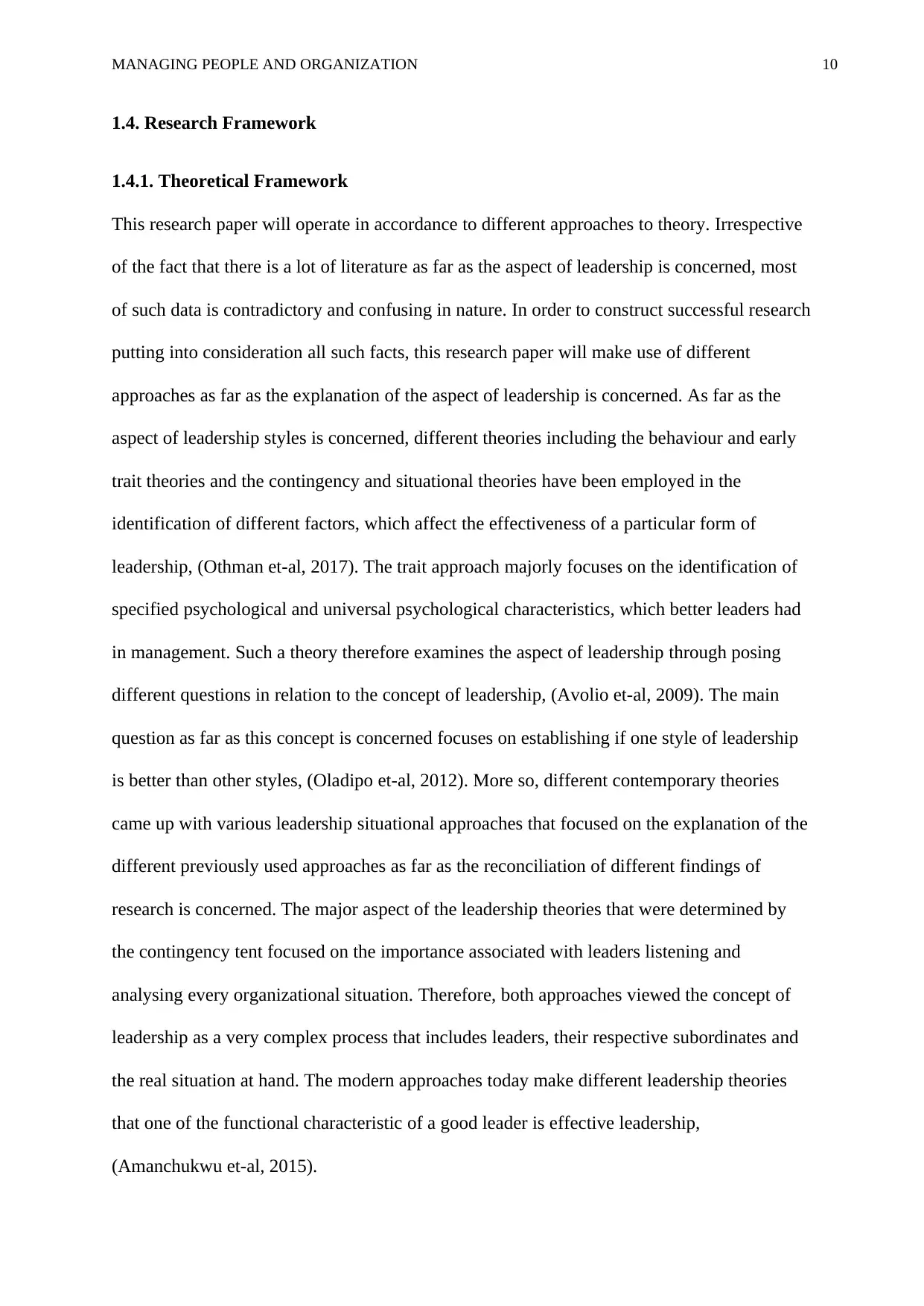
MANAGING PEOPLE AND ORGANIZATION 10
1.4. Research Framework
1.4.1. Theoretical Framework
This research paper will operate in accordance to different approaches to theory. Irrespective
of the fact that there is a lot of literature as far as the aspect of leadership is concerned, most
of such data is contradictory and confusing in nature. In order to construct successful research
putting into consideration all such facts, this research paper will make use of different
approaches as far as the explanation of the aspect of leadership is concerned. As far as the
aspect of leadership styles is concerned, different theories including the behaviour and early
trait theories and the contingency and situational theories have been employed in the
identification of different factors, which affect the effectiveness of a particular form of
leadership, (Othman et-al, 2017). The trait approach majorly focuses on the identification of
specified psychological and universal psychological characteristics, which better leaders had
in management. Such a theory therefore examines the aspect of leadership through posing
different questions in relation to the concept of leadership, (Avolio et-al, 2009). The main
question as far as this concept is concerned focuses on establishing if one style of leadership
is better than other styles, (Oladipo et-al, 2012). More so, different contemporary theories
came up with various leadership situational approaches that focused on the explanation of the
different previously used approaches as far as the reconciliation of different findings of
research is concerned. The major aspect of the leadership theories that were determined by
the contingency tent focused on the importance associated with leaders listening and
analysing every organizational situation. Therefore, both approaches viewed the concept of
leadership as a very complex process that includes leaders, their respective subordinates and
the real situation at hand. The modern approaches today make different leadership theories
that one of the functional characteristic of a good leader is effective leadership,
(Amanchukwu et-al, 2015).
1.4. Research Framework
1.4.1. Theoretical Framework
This research paper will operate in accordance to different approaches to theory. Irrespective
of the fact that there is a lot of literature as far as the aspect of leadership is concerned, most
of such data is contradictory and confusing in nature. In order to construct successful research
putting into consideration all such facts, this research paper will make use of different
approaches as far as the explanation of the aspect of leadership is concerned. As far as the
aspect of leadership styles is concerned, different theories including the behaviour and early
trait theories and the contingency and situational theories have been employed in the
identification of different factors, which affect the effectiveness of a particular form of
leadership, (Othman et-al, 2017). The trait approach majorly focuses on the identification of
specified psychological and universal psychological characteristics, which better leaders had
in management. Such a theory therefore examines the aspect of leadership through posing
different questions in relation to the concept of leadership, (Avolio et-al, 2009). The main
question as far as this concept is concerned focuses on establishing if one style of leadership
is better than other styles, (Oladipo et-al, 2012). More so, different contemporary theories
came up with various leadership situational approaches that focused on the explanation of the
different previously used approaches as far as the reconciliation of different findings of
research is concerned. The major aspect of the leadership theories that were determined by
the contingency tent focused on the importance associated with leaders listening and
analysing every organizational situation. Therefore, both approaches viewed the concept of
leadership as a very complex process that includes leaders, their respective subordinates and
the real situation at hand. The modern approaches today make different leadership theories
that one of the functional characteristic of a good leader is effective leadership,
(Amanchukwu et-al, 2015).
Paraphrase This Document
Need a fresh take? Get an instant paraphrase of this document with our AI Paraphraser
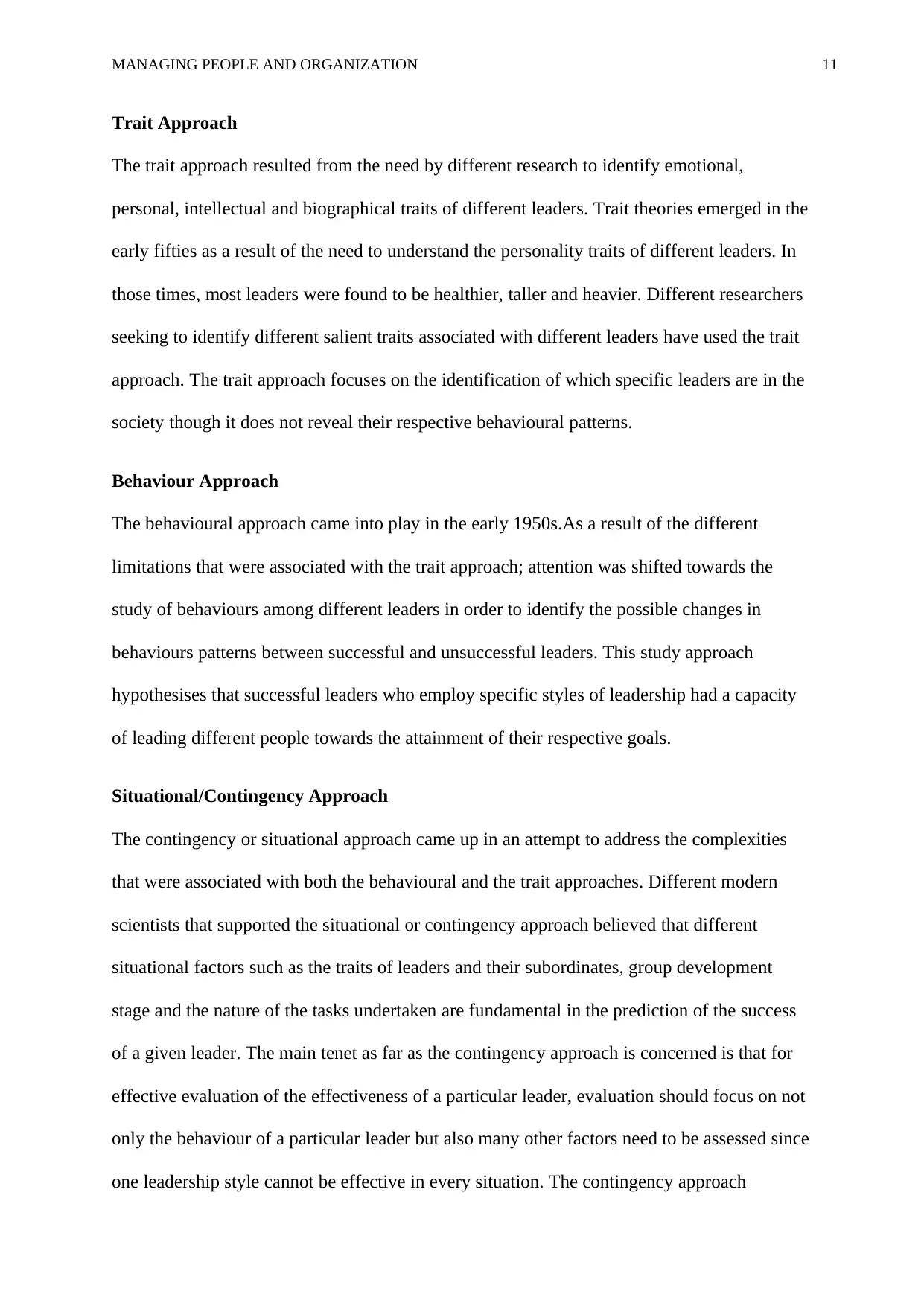
MANAGING PEOPLE AND ORGANIZATION 11
Trait Approach
The trait approach resulted from the need by different research to identify emotional,
personal, intellectual and biographical traits of different leaders. Trait theories emerged in the
early fifties as a result of the need to understand the personality traits of different leaders. In
those times, most leaders were found to be healthier, taller and heavier. Different researchers
seeking to identify different salient traits associated with different leaders have used the trait
approach. The trait approach focuses on the identification of which specific leaders are in the
society though it does not reveal their respective behavioural patterns.
Behaviour Approach
The behavioural approach came into play in the early 1950s.As a result of the different
limitations that were associated with the trait approach; attention was shifted towards the
study of behaviours among different leaders in order to identify the possible changes in
behaviours patterns between successful and unsuccessful leaders. This study approach
hypothesises that successful leaders who employ specific styles of leadership had a capacity
of leading different people towards the attainment of their respective goals.
Situational/Contingency Approach
The contingency or situational approach came up in an attempt to address the complexities
that were associated with both the behavioural and the trait approaches. Different modern
scientists that supported the situational or contingency approach believed that different
situational factors such as the traits of leaders and their subordinates, group development
stage and the nature of the tasks undertaken are fundamental in the prediction of the success
of a given leader. The main tenet as far as the contingency approach is concerned is that for
effective evaluation of the effectiveness of a particular leader, evaluation should focus on not
only the behaviour of a particular leader but also many other factors need to be assessed since
one leadership style cannot be effective in every situation. The contingency approach
Trait Approach
The trait approach resulted from the need by different research to identify emotional,
personal, intellectual and biographical traits of different leaders. Trait theories emerged in the
early fifties as a result of the need to understand the personality traits of different leaders. In
those times, most leaders were found to be healthier, taller and heavier. Different researchers
seeking to identify different salient traits associated with different leaders have used the trait
approach. The trait approach focuses on the identification of which specific leaders are in the
society though it does not reveal their respective behavioural patterns.
Behaviour Approach
The behavioural approach came into play in the early 1950s.As a result of the different
limitations that were associated with the trait approach; attention was shifted towards the
study of behaviours among different leaders in order to identify the possible changes in
behaviours patterns between successful and unsuccessful leaders. This study approach
hypothesises that successful leaders who employ specific styles of leadership had a capacity
of leading different people towards the attainment of their respective goals.
Situational/Contingency Approach
The contingency or situational approach came up in an attempt to address the complexities
that were associated with both the behavioural and the trait approaches. Different modern
scientists that supported the situational or contingency approach believed that different
situational factors such as the traits of leaders and their subordinates, group development
stage and the nature of the tasks undertaken are fundamental in the prediction of the success
of a given leader. The main tenet as far as the contingency approach is concerned is that for
effective evaluation of the effectiveness of a particular leader, evaluation should focus on not
only the behaviour of a particular leader but also many other factors need to be assessed since
one leadership style cannot be effective in every situation. The contingency approach
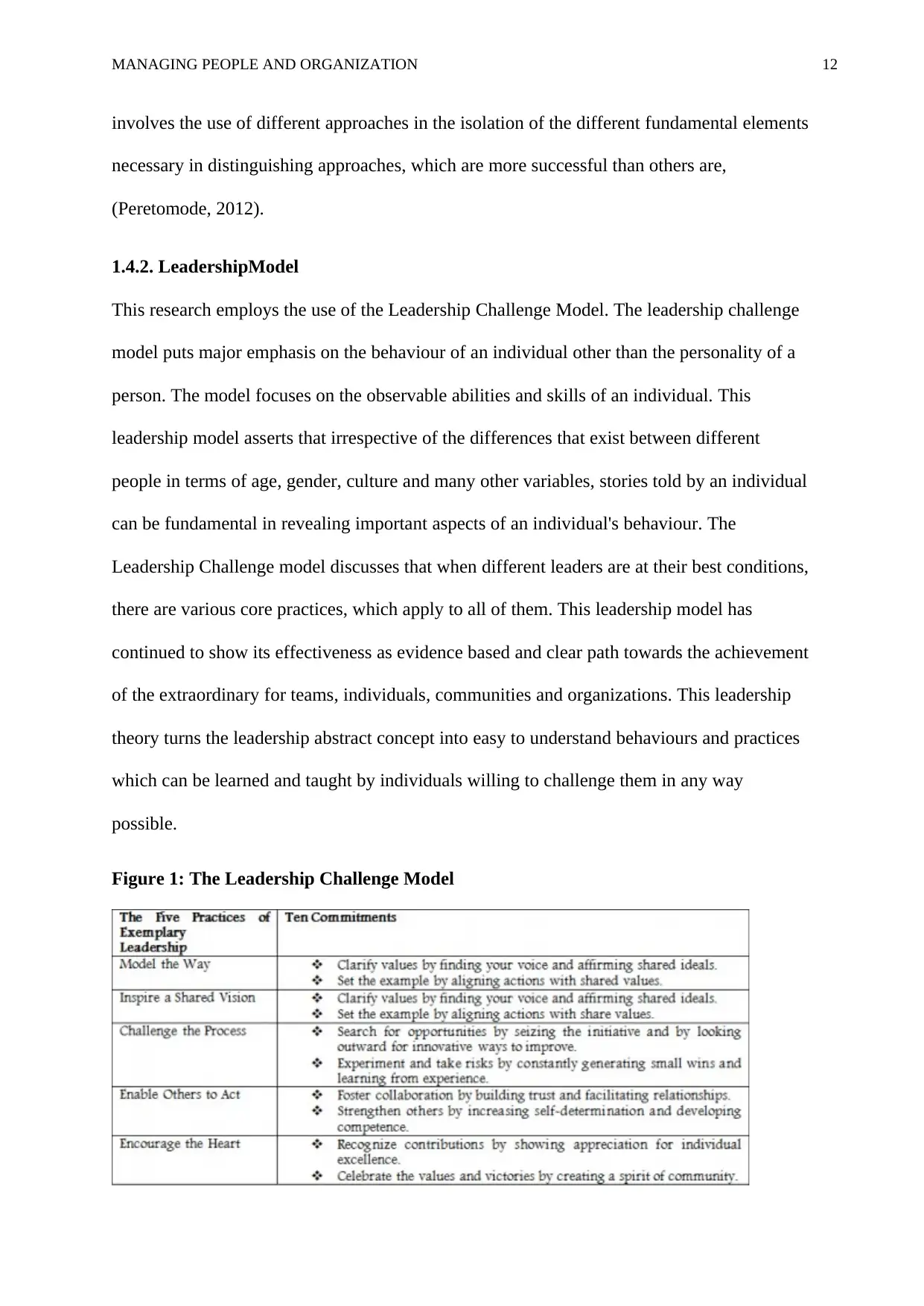
MANAGING PEOPLE AND ORGANIZATION 12
involves the use of different approaches in the isolation of the different fundamental elements
necessary in distinguishing approaches, which are more successful than others are,
(Peretomode, 2012).
1.4.2. LeadershipModel
This research employs the use of the Leadership Challenge Model. The leadership challenge
model puts major emphasis on the behaviour of an individual other than the personality of a
person. The model focuses on the observable abilities and skills of an individual. This
leadership model asserts that irrespective of the differences that exist between different
people in terms of age, gender, culture and many other variables, stories told by an individual
can be fundamental in revealing important aspects of an individual's behaviour. The
Leadership Challenge model discusses that when different leaders are at their best conditions,
there are various core practices, which apply to all of them. This leadership model has
continued to show its effectiveness as evidence based and clear path towards the achievement
of the extraordinary for teams, individuals, communities and organizations. This leadership
theory turns the leadership abstract concept into easy to understand behaviours and practices
which can be learned and taught by individuals willing to challenge them in any way
possible.
Figure 1: The Leadership Challenge Model
involves the use of different approaches in the isolation of the different fundamental elements
necessary in distinguishing approaches, which are more successful than others are,
(Peretomode, 2012).
1.4.2. LeadershipModel
This research employs the use of the Leadership Challenge Model. The leadership challenge
model puts major emphasis on the behaviour of an individual other than the personality of a
person. The model focuses on the observable abilities and skills of an individual. This
leadership model asserts that irrespective of the differences that exist between different
people in terms of age, gender, culture and many other variables, stories told by an individual
can be fundamental in revealing important aspects of an individual's behaviour. The
Leadership Challenge model discusses that when different leaders are at their best conditions,
there are various core practices, which apply to all of them. This leadership model has
continued to show its effectiveness as evidence based and clear path towards the achievement
of the extraordinary for teams, individuals, communities and organizations. This leadership
theory turns the leadership abstract concept into easy to understand behaviours and practices
which can be learned and taught by individuals willing to challenge them in any way
possible.
Figure 1: The Leadership Challenge Model
⊘ This is a preview!⊘
Do you want full access?
Subscribe today to unlock all pages.

Trusted by 1+ million students worldwide
1 out of 37
Related Documents
Your All-in-One AI-Powered Toolkit for Academic Success.
+13062052269
info@desklib.com
Available 24*7 on WhatsApp / Email
![[object Object]](/_next/static/media/star-bottom.7253800d.svg)
Unlock your academic potential
Copyright © 2020–2025 A2Z Services. All Rights Reserved. Developed and managed by ZUCOL.





